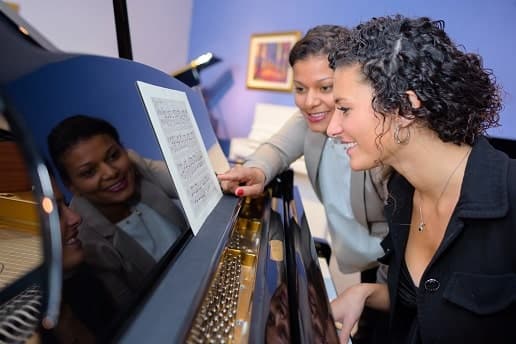How to improve piano sight reading: If you’re a pianist who wants to take your sight-reading skills to the next level, look no further! Sight-reading is an important skill for any musician, and learning how to do it well can open up a world of musical possibilities. In this article, we will discuss some tips and strategies that will help you improve piano sight reading.

We’ll talk about practice techniques, ways to build confidence in yourself as a reader, and more. By following these simple steps, you’ll be able to tackle even the most challenging pieces of music with ease. So let’s get started on improving your piano sight reading today!
How To Improve Piano Sight Reading Skills
Sight reading refers to the ability to quickly read and play a piece of music without prior knowledge or preparation. As a pianist, you want to be able to look at a sheet of music and start playing on the spot. To do this, it’s important to practice good sight-reading techniques.

Here are some helpful tips that can help you improve your piano sight reading.
1. Learn Music Notation
Music notation is like a language and it’s important to become familiar with the symbols and how they indicate notes, rhythms, dynamics, and more. The better you know music notation, the easier it will be for you to sight-read a piece of music.
2. Practice Sight Reading Regularly
Regular practice of sight reading is essential if you want to improve your skills. Set aside time in your practice schedule for sight reading, and make sure you are challenging yourself with pieces that test your speed and accuracy.
3. Memorize the Keyboard
Being able to play notes on the fly requires a basic understanding of how the piano keyboard works. Spend some time memorizing which keys are where, and which notes correspond with each hand. Also, make sure you have a good-quality piano in the first place. If you are planning on buying a piano, here is the best digital Yamaha piano for you.
4. Use a Metronome
A metronome can be a great tool to help you with your sight-reading skills. Set the tempo of the music as slow as needed, and gradually increase it as you become more comfortable with the piece. This will help you stay on track, even when the music gets more complex.
5. Build Confidence
Playing a piece of music “cold” can be intimidating, but it’s important to have faith in yourself as a reader. Believe that you can do it and trust your instincts when sight reading. With enough practice, you will eventually develop the confidence needed to tackle even the most challenging pieces.
6. Practice with One Hand at a Time
If you want to truly master piano sight reading, try breaking down the piece into parts and practice each hand separately. This will help you better understand the individual notes and rhythms of each voice, as well as how they all fit together.
7. Use Sight Reading Books
This is another great way to improve piano sight reading. Sight reading books offer a wide range of exercises that can help you hone your skills, from simple scales and chords to more complex pieces of music.
By following these tips, you should be well on your way to becoming a better piano sight reader. With enough dedication and practice, you’ll eventually be able to tackle any piece of music that comes your way. Good luck!
Conclusion
That was all about how to improve piano sight reading. By following these simple tips, you’ll be able to improve your piano sight reading skills in no time. With these tips in mind, you should be well on your way to improving your sight-reading skills. We hope this article was helpful and we wish you the best of luck in your musical journey! Happy practicing! Be in touch with us for digital piano reviews 2023 and for more useful tips.